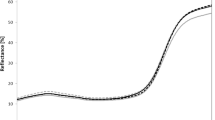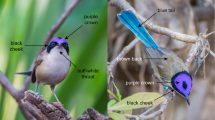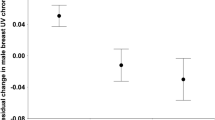Abstract
Animals may assess the quality of other individuals by using information that different ornaments may provide. The European Roller (Coracias garrulus) is a socially monogamous species in which males and females display highly conspicuous plumage colouration. According to the mutual selection hypothesis, we predicted that, in this species, plumage coloration could signal individual quality in both sexes because both female and male rollers invest a considerable amount of time caring for their offspring. We used spectrophotometric measurements to investigate the information content of multiple plumage colour traits. We found that the roller is actually a sexually dimorphic and dichromatic species. Different plumage colours from different origins were correlated within individual. Head and back brightness correlated with body condition in both sexes, and in males, head brightness correlated with the number of fledglings in successful nests, while head green-yellow saturation correlated with parental provisioning. Meanwhile, in females, back brightness was related to the number of fledglings in successful nests and to parental provisioning rate. In addition, there was a positive assortative mating in relation to weight, body condition, head green-yellow saturation and back brightness. Finally, we found a positive correlation between parent and offspring coloration. Altogether, these results suggest that multiple colour traits may act as quality indicators in the roller and that they may be used by the two sexes to assess potential mate quality.



Similar content being viewed by others
References
Amundsen T (2000) Why are female birds ornamented? Trends Ecol Evol 15:149–155
Amundsen T, Pärn H (2006) Female coloration: review of functional and non-functional hypothesis. In: Hill GE, McGraw KJ (eds) Bird coloration, vol. II: function and evolution. Harvard University Press, Harvard, pp 280–348
Amundsen T, Forsgren E, Hansen LTT (1997) On the function of female ornaments: male bluethroats prefer colourful females. Proc R Soc Lond B Biol Sci 264:1579–1586
Andersson M (1994) Sexual selection. Princeton University Press, New Jersey
Andersson S, Örnborg J, Andersson M (1998) Ultraviolet sexual dimorphism and assortative mating in blue tits. Proc R Soc Lond B Biol Sci 265:445–450
Andersson S, Pryke SR, Örnborg J, Lawes MJ, Andersson M (2002) Multiple receivers, multiple ornaments, and a trade-off between agonistic and epigamic signaling in a widowbird. Am Nat 160:683–691
Avilés JM (2006) Carraca europea–Coracias garrulus. In: Carrascal LM, Salvador A (eds). Enciclopedia Virtual de los Vertebrados Españoles. Museo Nacional de Ciencias Naturales. http://www.vertebradosibericos.org
Avilés JM, Sánchez JM, Sánchez A, Parejo D (1999) Breeding biology of the Roller Coracias garrulus in farming areas of the southwest Iberian Peninsula. Bird Study 46:217–223
Avilés JM, Sánchez JM, Parejo D (2000) Nest-site selection and breeding success in the Roller (Coracias garrulus) in the Southwest of the Iberian península. Journal für Ornithologie 141:345–350
Avilés JM, Solís E, Valencia J, de la Cruz C, Sorci G (2008) Female and male plumage brightness correlate with nesting failure in azure-winged magpies. J Avian Biol 39:257–261
Badyaev AV, Hill GE (2000) Evolution of sexual dichromatism: contribution of carotenoid-versus melanin-based coloration. Biol J Linn Soc 69:153–172
Bize P, Gasparini J, Klopfenstein A, Altwegg R, Roulin A (2006) Melanin-based coloration is a nondirectionally selected sex-specific signal of offspring development in the Alpine swift. Evolution 60:2370–2380
Cramp S, Simmons KEL (1988) The birds of the western Palearctic, vol. V. Oxford University Press, Oxford
Cuthill IC, Partridge JC, Bennett ATD, Church SC, Hart NS, Hunt S (2000) Ultraviolet vision in birds. Adv Stud Behav 29:159–214
Darwin C (1871) The descent of man and selection in relation to sex. London, Murray
Doucet SM (2002) Structural plumage coloration, male body size, and condition in the blue-black grassquit. Condor 104:30–38
Doucet SM, Montgomerie R (2003) Multiple sexual ornaments in satin bowerbirds: ultraviolet plumage and bowers signal different aspects of male quality. Behav Ecol 14:503–509
Eaton MD (2005) Human vision fails to distinguish widespread sexual dichromatism among sexually “monochromatic” birds. Proc Natl Acad Sci USA 102:10942–10946
Emlen DJ, Hunt J, Simmons LW (2005) Evolution of sexual dimorphism and male dimorphism in the expression of beetle horns: phylogenetic evidence for modularity, evolutionary lability, and constraint. Am Nat 166:S42–S68
Fargallo JA, Laaksonen T, Korpimäki E, Wakamatsu K (2007) A melanin-based trait reflects environmental growth conditions of nestling male Eurasian kestrels. Evol Ecol 21:157–171
Fridolfsson AK, Ellegren H (1999) A simple and universal method for molecular sexing of non-ratite birds. J Avian Biol 30:116–121
Grafen A (1990) Sexual selection unhandicapped by the Fisher process. J Theor Biol 144:473–516
Goldsmith TH (1980) Hummingbirds see near ultraviolet light. Science 207:786–788
Green R (1979) Sampling design and statistical methods for environmental biologists. Wiley, New York
Griffith SC, Owens IPF, Burke T (1999) Environmental determination of sexually selected trait. Nature 400:358–360
Griffith SC, Parker TH, Olson VA (2006) Melanin- versus carotenoid-based sexual signals: is the difference really so black and red? Anim Behav 71:749–763
Hamilton WD, Zuk M (1982) Heritable true fitness and bright birds: a role for parasites? Science 218:384–387
Heywood JS (1989) Sexual selection by the handicap mechanism. Evolution 43:1387–1397
Hill GE (1990) Female house finches prefer colourful males: sexual selection for a condition-dependent trait. Anim Behav 40:563–572
Hill GE (2006) Environmental regulation of ornamental coloration. In: Hill GE, McGraw KJ (eds) Bird coloration, vol. 1: Mechanism and measurements. Harvard University Press, Harvard, pp 507–560
Hill GE, Doucet SM, Buchholz R (2005) The effect of coccidial infection on iridescent plumage coloration in wild turkeys. Anim Behav 69:387–394
Hill GE, McGraw KJ (2006a) Preface. In: Hill GE, McGraw KJ (eds) Bird coloration, vol. 1: Mechanism and measurements. Harvard University Press, Harvard, pp vii–viii
Hill GE, McGraw KJ (2006b) Bird coloration, vol. 1: Mechanism and measurements. Harvard University Press, Harvard
Hoelzer GA (1989) The good parent process of sexual selection. Anim Behav 38:1067–1078
Huxley JS (1914) The courtship habits of the great crested grebe (Podiceps cristatus); with an addition to the theory of sexual selection. Proc R Soc Lond B Biol Sci 35:491–562
Jawor JM, Breitwisch R (2004) Multiple ornaments in male northern cardinals, Cardinalis cardinalis, as indicators of condition. Ethology 110:113–126
Johnsen TS, Hengeveld JD, Blank JL, Yasukawa K, Nolan V (1996) Epaulet brightness and condition in female redwinged blackbirds. Auk 113:356–362
Johnsen A, Delhey K, Andersson S, Kempenaers B (2003) Plumage colour in nestling blue tits: sexual dichromatism, condition dependence and genetic effects. Proc R Soc Lond B Biol Sci 270:1263–1270
Johnstone RA (1997) The tactics of mutual mate choice and competitive search. Behav Ecol Sociobiol 40:51–59
Johnstone RA, Reynolds JD, Deutsch JC (1996) Mutual mate choice and sex differences in choosiness. Evolution 50:1382–1391
Keyser AJ, Hill GE (1999) Condition-dependent variation in the blue-ultraviolet coloration of a structurally based plumage ornament. Proc R Soc Lond B Biol Sci 266:771–777
Keyser A, Hill GE (2000) Structurally based plumage coloration is an honest signal of quality in male blue grosbeaks. Behav Ecol 11:202–209
Kodric-Brown A, Brown JH (1984) Truth in advertising: the kinds of traits favored by sexual selection. Am Nat 124:309–323
Kokko H, Johnstone RA (2002) Why is mutual mate choice not the norm? Operational sex ratios, sex roles and the evolution of sexually dimorphic and monomorphic signalling. Proc R Soc Lond B Biol Sci 357:319–330
Kraaijeveld K, Kraaijeveld-Smit FJL, Komdeur J (2007) The evolution of mutual ornamentation. Anim Behav 74:657–677
Lande R (1980) Sexual dimorphism, sexual selection, and adaptation in polygenic characters. Evolution 34:292–305
Ligon JD, Zwartjes PW (1995) Ornate plumage of male red junglefowl does not influence mate choice by females. Anim Behav 49:117–125
McGraw KJ, Hill GE (2000) Differential effects of endoparasitism on the expression of carotenoid- and melanin-based ornamental coloration. Proc R Soc Lond B Biol Sci 267:1525–1531
McGraw KJ, Mackillop EA, Dale J, Hauber ME (2002) Different colors reveal different information: how nutritional stress affects the expression of melanin- and structurally based ornamental plumage. J Exp Biol 205:3747–3755
McGraw KJ, Hudon J, Hill GE, Parker RS (2005) A simple and inexpensive chemical test for behavioral ecologists to determine the presence of carotenoid pigments in animal tissues. Behav Ecol Sociobiol 57:391–397
Møller AP, Pomiankowski A (1993) Why have birds got multiple sexual ornaments. Behav Ecol Sociobiol 32:167–176
Mundy NI (2006) Genetic basis of color variation in wild birds. In: Hill GE, McGraw KJ (eds) Bird coloration, vol. 1: Mechanisms and measurements. Harvard University Press, Harvard, pp 469–506
Ödeen A, Håstad O (2003) Complex distribution of avian color vision systems revealed by sequencing the SWS1 opsin from total DNA. Mol Biol Evol 20:855–861
Omland KE (1996) Female mallard mating preferences for multiple male ornaments. Behav Ecol Sociobiol 39:353–36
Parejo D, Silva N, Avilés JM (2007) Within-brood size differences affect innate and acquired immunity in roller Coracias garrulus nestlings. J Avian Biol 38:717–725
Potti J, Merino S (1996) Decreased levels of blood trypanosome infection correlate with female expression of a male secondary sexual trait: Implications for sexual selection. Proc R Soc Lond B Biol Sci 263:1199–1204
Roulin A (1999) Nonrandom pairing by male barn owls (Tyto alba) with respect to a plumage trait. Behav Ecol 10:688–695
Roulin A, Dijkstra C (2003) Genetic and environmental components of variation in eumelanin and phaeomelanin sex-traits in the barn owl. Heredity 90:359–364
Servedio MR, Lande R (2006) Population genetic models of male and mutual mate choice. Evolution 60:674–685
Siefferman L, Hill GE (2003) Structural and melanin coloration indicate parental effort and reproductive success in male eastern bluebirds. Behav Ecol 14:855–861
Siefferman L, Hill GE (2005a) Evidence for sexual selection on structural plumage coloration of female eastern bluebirds. Evolution 59:1819–1828
Siefferman L, Hill GE (2005b) Blue structural coloration of male eastern bluebirds Sialia sialis predicts incubation provisioning to females. J Avian Biol 36:488–493
Solís E, Avilés JM, de la Cruz C, Valencia J, Sorci G (2008) Winter male plumage coloration correlates with breeding status in a cooperative breeding species. Behav Ecol 19:391–397
Trivers RL (1972) Parental investment and sexual selection. In: Campbell B (ed) Sexual selection and the descent of man 1871–1971. Aldine, Chicago, IL, pp 136–179
Veiga JP, Puerta M (1996) Nutritional constraints determine the expression of a sexual trait in the house sparrow, Passer domesticus. Proc R Soc Lond B Biol Sci 263:229–234
Von Schantz TV, Bensch S, Grahn M, Hasselquist D, Wittzell H (1999) Good genes, oxidative stress and condition-dependent sexual signals. Proc R Soc Lond B Biol Sci 266:1–12
West-Eberhard MJ (1979) Sexual selection, social competition, and evolution. P Am Phil Soc 123:222–234
Zahavi A (1975) Mate selection—a selection for a handicap. J Theor Biol 53:205–214
Zahavi A, Zahavi A (1997) The Handicap Principle: a missing piece of Darwin’s puzzle. Oxford University Press, Oxford
Zuk M, Thornhill R, Ligon JD, Johnson K, Austad S, Ligon S, Thornhill N, Costin C (1990) The role of male ornaments and courtship behavior in female choice of red jungle fowl. Am Nat 136:459–473
Zuk M, Ligon JD, Thornhill R (1993) Effects of experimental manipulation of male secondary sex characters on female mate preference in red jungle fowl. Anim Behav 44:999–1006
Acknowledgments
We thank all the people who collaborated in data collection either in the field (L. Derousse, M. Guillemin, M. Kauffman, M. Kriloff, C. Landsmann, V. Lartigot, X. Mandine and G. Martinerie) or in the laboratory (J. M. Gasent). We also thank I. Cuthill and one anonymous referee for constructive comments that improved our manuscript. Fieldwork was done under the permission of the Junta de Extremadura and in compliance with the Spanish laws. This research work was partially supported by a doctoral grant to NS by the European Social Fund, an I3P contract to DP funded by the European Social Fund and by the Spanish Ministerio de Educación y Ciencia-FEDER, Secretaría de Estado de Universidades e Investigación, (project ref. CGL2005-04654/BOS).
Author information
Authors and Affiliations
Corresponding author
Additional information
Communicated by I. Cuthill
Rights and permissions
About this article
Cite this article
Silva, N., Avilés, J.M., Danchin, E. et al. Informative content of multiple plumage-coloured traits in female and male European Rollers. Behav Ecol Sociobiol 62, 1969–1979 (2008). https://doi.org/10.1007/s00265-008-0628-y
Received:
Revised:
Accepted:
Published:
Issue Date:
DOI: https://doi.org/10.1007/s00265-008-0628-y




